
Featured Blog | This community-written post highlights the best of what the game industry has to offer. Read more like it on the Game Developer Blogs or learn how to Submit Your Own Blog Post
Video Game Composers: The Tech of Music in Virtual Reality (GDC 2018)
Video game composer Winifred Phillips presents extra research & scholarship gathered for her GDC 2018 talk: Music in Virtual Reality. This tech info (not included in the talk) is useful for composers & audio pros interested in music strategies for VR.

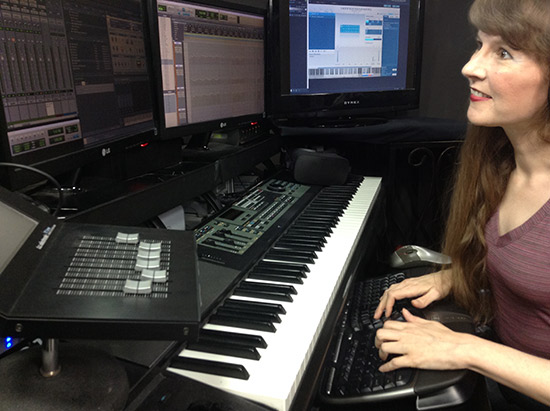
By Winifred Phillips | Contact | Follow
The Game Developers Conference is almost here! I'm looking forward to giving my presentation soon on "Music in Virtual Reality" (Thursday, March 22nd at 3pm in room 3002 West Hall, Moscone Center, San Francisco). Over the course of the last two years, I've composed a lot of music for virtual reality projects, some of which have already hit retail, and some of which will be getting released very soon! As a result, I've spent a lot of time thinking about what role music should play in a virtual reality game. During my GDC talk in March, I'll be taking my audience through my experiences composing music for four very different VR games –the Bebylon: Battle Royale game from Kite & Lightning, the Dragon Front strategy game from High Voltage Software, the Fail Factory comedy game from Armature Studio, and the Scraper: First Strike RPG-Shooter hybrid from Labrodex Inc. In preparing my GDC presentation, I made sure my talk addressed some of the most important creative and technical hurdles facing video game composers working in VR. However, time constraints ensured that some interesting info ended up 'on the cutting room floor,' so to speak. So, I've written two articles that explore some of the best topics that didn't make it into my GDC presentation.
My previous article focused on some abstract, creative concerns facing video game music composers and audio folks working in VR. In this article, we'll be turning our attention to more concrete technical issues. Ready? Let's go.
New Binaural Development
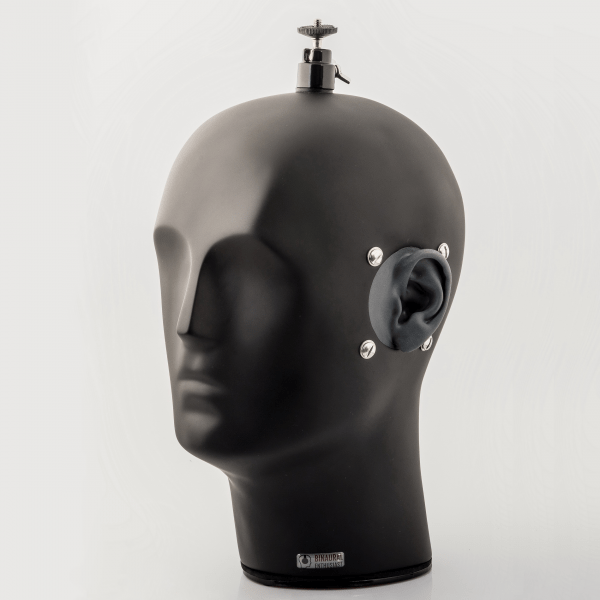 VR games currently focus on binaural audio to immerse players in the awesome soundscapes of their virtual worlds. As we know, binaural recording techniques use two microphones, often embedded in the artificial ears of a dummy head (pictured right). By virtual of the popular binaural recording technique and/or binaural encoding technologies, game audio teams can plunge VR players into convincing aural worlds where sounds are spatially localized in a way that conforms with real world expectations. The technology of binaural sound continually improves, and recently the expert developers of the Oculus Rift VR headset have refined the quality of their VR sound with two significant upgrades.
VR games currently focus on binaural audio to immerse players in the awesome soundscapes of their virtual worlds. As we know, binaural recording techniques use two microphones, often embedded in the artificial ears of a dummy head (pictured right). By virtual of the popular binaural recording technique and/or binaural encoding technologies, game audio teams can plunge VR players into convincing aural worlds where sounds are spatially localized in a way that conforms with real world expectations. The technology of binaural sound continually improves, and recently the expert developers of the Oculus Rift VR headset have refined the quality of their VR sound with two significant upgrades.
First, they have introduced "Near-Field Head Related Transfer Function." We're all probably familiar by now with the concept of Head Related Transfer Function (HRTF), in which sound interacts with our heads, bodies and ear canals on its way to our ear drums. The subtle changes undergone by those sound waves endow them with the specific qualities that reflect the real-life aural world. In the original Oculus Audio SDK, realistic HRTF was limited by distance. Sounds that occurred a meter away or more would reach us with all the correct HRTF effects we'd expect, but when sounds were emitted within that meter-wide diameter around our heads, the HRTF effects would no longer function. So now the Oculus team has introduced "Near-Field HRTF" to fill in that gap. This allows sounds that might occur close to our heads to feel more realistic.
Near-Field HRTF might have great applications for game composers interested in employing diegetic music that occurs close to the player, such as a musical instrument that the player is expected to 'play,' or a music-emitting device (a radio, a music box) that's held in the player's hand. Here's a video produced by the Oculus team that demonstrates Near-Field HRTF in action:
The second binaural audio upgrade from the Oculus team allows for "Volumetric Sound Sources." This is a simpler effect to understand, but with more interesting implications for music inside the VR space. "Volumetric Sound Sources let sound designers model objects of virtually any size in a way that sounds realistic," explains the Oculus team. "Rather than trying to pinpoint the source of a sound, designers can give a sound a radius—the larger the assigned radius, the larger the sound’s source."
Theoretically, this effect should make a single sound source emit a more expansive breadth of sound, sidestepping the otherwise mono-like qualities that many object-based sound sources typically display. When implementing music in ways that attach it to the environment (such as audio mixes that separate instrument sections and spread them out across the virtual landscape), this kind of "Volumetric" effect would prevent these sounds from feeling as though they each emanate from a single point. For instance, a violin section might have the wider breadth expected from such a recording. Here's the video produced by the Oculus team that demonstrates this effect. Unfortunately, in the video the developers focused on white noise-heavy sounds like rushing/falling water, hissing machinery noises, and ocean surf. This is less than revealing for other types of sound (such as musical sources), but it might give us a general idea of the developers' intentions:
Both of these recent innovations depend on the binaural delivery system in order to function. Binaural is currently very important in VR audio, and is likely to remain important for some time to come.
However useful binary audio may be for VR audio design, binaural also has some logistical drawbacks for the consumer. Let's take a look at those, and examine some solutions that have been proposed.
The headphones problem
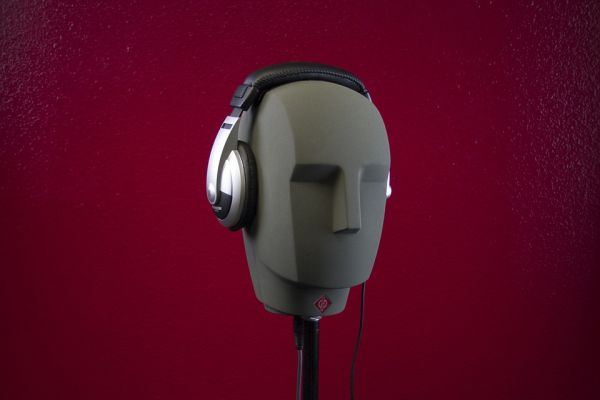 In today's modern high-tech environment, smart devices are everywhere. One of the defining characteristics of a smart device is its ability to identify itself when used in combination with other technologies. Smart devices are essentially plug and play. We can plug a smart device such as the famous iPhone into a computer, and the computer will immediately know what it is. Lots of peripheral devices are instantly recognizable, such as keyboards, game controllers, hard drives, etc. Most standard headphones, however, aren't smart devices. When we plug them into a computer for use with a VR system, the system won't be able to identify the headphone model, nor will it be able to detect any onboard signal processing such as noise cancellation or spatial rendering (surround sound or binaural). That means that the VR system can't automatically compensate for the headphone technology currently plugged into it. This is where things can go wrong.
In today's modern high-tech environment, smart devices are everywhere. One of the defining characteristics of a smart device is its ability to identify itself when used in combination with other technologies. Smart devices are essentially plug and play. We can plug a smart device such as the famous iPhone into a computer, and the computer will immediately know what it is. Lots of peripheral devices are instantly recognizable, such as keyboards, game controllers, hard drives, etc. Most standard headphones, however, aren't smart devices. When we plug them into a computer for use with a VR system, the system won't be able to identify the headphone model, nor will it be able to detect any onboard signal processing such as noise cancellation or spatial rendering (surround sound or binaural). That means that the VR system can't automatically compensate for the headphone technology currently plugged into it. This is where things can go wrong.
What if a pair of surround-sound headphones are plugged into a VR gaming device outputting in binaural sound? The VR game's binaural audio is going to get spatially reprocessed by the headphones, resulting in a serious degradation of the sound quality. Consumers are accustomed to their devices communicating with each other and sorting these sorts of issues out autonomously. If the VR system is smart, but the headphones are essentially dumb, what then?
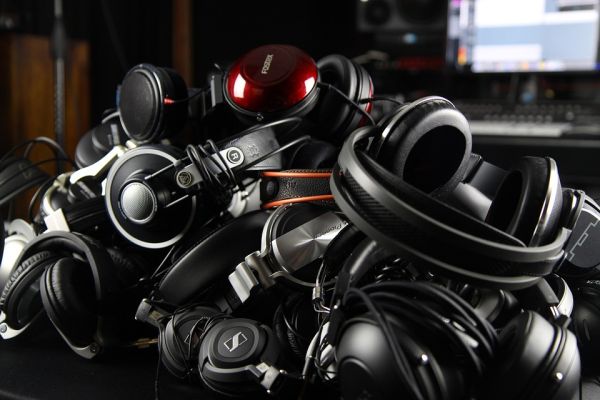 "For any poorly perceived mix, the user may not know what the problem is or how to go about rectifying it. Even worse the user may even assume the poor mix is a fault of the game’s audio engine," observed audio programmer Aristotel Digenis in his presentation "Challenges of the Headphone Mix in Games" at the 56th Audio Engineering Society Conference. "Smart headphones" may be the natural evolution for headphones," Digenis points out. "The analogue nature of conventional headphones means they have no way of identifying themselves in an equipment eco-system that is rapidly able to identify one another and each other’s capabilities."
"For any poorly perceived mix, the user may not know what the problem is or how to go about rectifying it. Even worse the user may even assume the poor mix is a fault of the game’s audio engine," observed audio programmer Aristotel Digenis in his presentation "Challenges of the Headphone Mix in Games" at the 56th Audio Engineering Society Conference. "Smart headphones" may be the natural evolution for headphones," Digenis points out. "The analogue nature of conventional headphones means they have no way of identifying themselves in an equipment eco-system that is rapidly able to identify one another and each other’s capabilities."
So, in an ideal world, the VR system would be able to identify the nature of the headphones and adjust its output accordingly. We can all hope that smart headphones will eventually appear on the high-tech horizon, but what about the other end of the equation? Can VR audio systems provide multiple audio mixes for different types of headphones? Aristotel Digenis proposes a way in which this can be achieved... although it includes the use of a new audio format, and a dramatic re-evaluation of the way in which VR audio is currently delivered.
MPEG-H
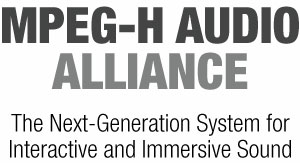 First announced in 2013, the MPEG-H 3D Audio coding standard supports multiple audio channel output configurations including binaural rendering and higher order ambisonics. One of the advantages of MGEG-H is its compatibility with multiple audio playback systems, from simple stereo, to complex surround configurations, to interactive virtual reality audio systems. This flexible delivery mechanism, which the designers have coined Universal Delivery, allows the MPEG-H format to be cross-compatible with any type of listening equipment, from simple stereo headphones all the way to the most sophisticated home theater setups. In other words, MPEG-H would allow VR audio to work on any playback system instead of its current limitation to headphones alone.
First announced in 2013, the MPEG-H 3D Audio coding standard supports multiple audio channel output configurations including binaural rendering and higher order ambisonics. One of the advantages of MGEG-H is its compatibility with multiple audio playback systems, from simple stereo, to complex surround configurations, to interactive virtual reality audio systems. This flexible delivery mechanism, which the designers have coined Universal Delivery, allows the MPEG-H format to be cross-compatible with any type of listening equipment, from simple stereo headphones all the way to the most sophisticated home theater setups. In other words, MPEG-H would allow VR audio to work on any playback system instead of its current limitation to headphones alone.
"Widespread adoption of the MPEG-H standard could mean game developers may not need to provide binaural mixes for their users," Digenis asserts. "Instead they can continue delivering multi-channel mixes to the console/A V system, and it can provide a suitable binaural mix to the user if they are using headphones."
Currently, the developers of MPEG-H are concentrating their focus on TV broadcast applications. Here's a short video demonstration of the television use of MPEG-H. Notice how the audio content remains interactive on a highly detailed level, allowing the manipulation of individual sonic elements by the end-user.
While it seems like the MPEG-H format is a long way from practical implementation in VR applications, it shows some promise in providing future options for game audio folks working in VR. We can imagine a future in which a virtual reality game may have its audio recorded and mixed in ambisonics, and then output in any number of configurations depending on the nature of the sound playback system.
Creating more opportunities for ambisonics to flourish in VR audio is an interesting topic to consider. Let's examine one intriguing possibility.
Ambisonics and the orchestra
In October of last year I wrote an article about some of the VR topics discussed at the Virtual Reality Developers Conference. As a part of that article, I touched upon an idea that was briefly mentioned by Jay Steen of Criterion Games during his talk about the audio of Star Wars Battlefront Rogue One X-Wing VR Mission. During the Q&A portion of his talk, Steen was asked about spatial positioning for a Star Wars musical score in VR. “We did do a quick experiment on it, and we found that it’s like having an orchestra sitting around you,” Steen observed. “We didn’t want to evoke you sitting in the middle of an orchestral recording. We just wanted it to sound like the movie.” Even with that seeming dismissal of a spatially-positioned Star Wars score, Steen went on to add, “Ambisonic recordings of orchestras for example, I think there’s something fun there. We haven’t experimented with it anymore than that, but yeah, definitely, we’d want to try."
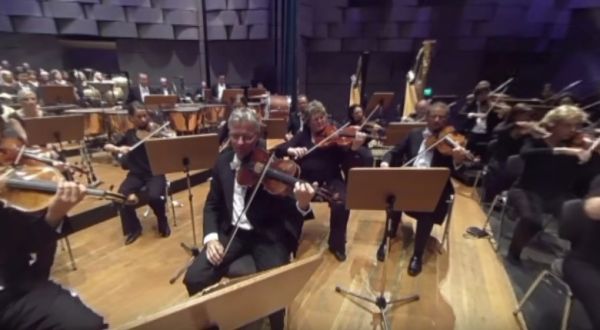 Ambisonic orchestral recordings are not often encountered in VR games, but they're becoming a bit more common in other forms of virtual entertainment. As a way to imagine how ambisonic orchestral recordings might be deployed in future VR games, let's take a look at an experiment undertaken by the Institute of Communication Systems at RWTH Aachen University in Germany. In April of last year, the Institute began a cooperative venture with the Aachen Symphony Orchestra. Over the course of several months, the orchestra was recorded with an em32 Eigenmike microphone array, which is capable of recording 32 channels of audio for fourth-order ambisonics. They placed the microphone in the middle of the string section, and also positioned a 36o° camera at the microphone array location so that a VR video could be made. The result replicates the experience of sitting right in the middle of the orchestra during a live concert.
Ambisonic orchestral recordings are not often encountered in VR games, but they're becoming a bit more common in other forms of virtual entertainment. As a way to imagine how ambisonic orchestral recordings might be deployed in future VR games, let's take a look at an experiment undertaken by the Institute of Communication Systems at RWTH Aachen University in Germany. In April of last year, the Institute began a cooperative venture with the Aachen Symphony Orchestra. Over the course of several months, the orchestra was recorded with an em32 Eigenmike microphone array, which is capable of recording 32 channels of audio for fourth-order ambisonics. They placed the microphone in the middle of the string section, and also positioned a 36o° camera at the microphone array location so that a VR video could be made. The result replicates the experience of sitting right in the middle of the orchestra during a live concert.
The Institute of Communication Systems reports that "the recorded content will be used for future research activities in the area of audio signal processing for immersive audio systems, e.g., 3D audio formats, binaural signal processing and spatial audio playback." So these experiments may yield results that prove to be useful to game music composers working on VR projects. Here's a video of one of the recorded performances of the Aachen Symphony Orchestra. Remember to wear headphones when listening, and feel free to swing the camera view in all directions!
Conclusion
In my past two articles, I’ve shared some of the additional research I’d encountered that didn’t make the cut for my GDC 2018 presentation, 'Music in Virtual Reality' (Thursday, March 22nd at 3pm in room 3002 West Hall, Moscone Center, San Francisco). The presentation I will give at GDC 2018 will include lots of practical and concrete techniques and strategies for video game music composers and audio folks looking to implement music strategically and effectively within VR. That being said, the more general research and techniques in these two articles can also provide helpful insight. I’ve included the official GDC description of my upcoming talk below. Please feel free to share your thoughts and insights in the comments section at the end of this article!
This lecture will present ideas for creating a musical score that complements an immersive VR experience. Composer Winifred Phillips will share tips from several of her VR projects. Beginning with a historical overview of positional audio technologies, Phillips will address several important problems facing composers in VR. Topics will include 3D versus 2D music implementation, and the role of spatialized audio in a musical score for VR. The use of diegetic and non-diegetic music will be explored, including methods that blur the distinction between the two categories. The discussion will also include an examination of the VIMS phenomenon (Visually Induced Motion Sickness), and the role of music in alleviating its symptoms. Phillips' talk will offer techniques for composers and audio directors looking to utilize music in the most advantageous way within a VR project. Takeaway Through examples from several VR games, Phillips will provide an analysis of music composition strategies that help music integrate successfully in a VR environment. The talk will include concrete examples and practical advice that audience members can apply to their own games. Intended Audience This session will provide composers and audio directors with strategies for designing music for VR. It will include an overview of the history of positional sound and the VIMS problem (useful knowledge for designers.) The talk will be approachable for all levels (advanced composers may better appreciate the specific composition techniques discussed). |
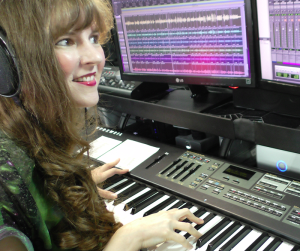 Winifred Phillips is an award-winning video game music composer whose most recent projects are the triple-A first person shooter Homefront: The Revolution and the Dragon Front VR game for Oculus Rift. Her credits include games in five of the most famous and popular franchises in gaming: Assassin’s Creed, LittleBigPlanet, Total War, God of War, and The Sims. She is the author of the award-winning bestseller A COMPOSER'S GUIDE TO GAME MUSIC, published by the MIT Press. As a VR game music expert, she writes frequently on the future of music in virtual reality games.
Winifred Phillips is an award-winning video game music composer whose most recent projects are the triple-A first person shooter Homefront: The Revolution and the Dragon Front VR game for Oculus Rift. Her credits include games in five of the most famous and popular franchises in gaming: Assassin’s Creed, LittleBigPlanet, Total War, God of War, and The Sims. She is the author of the award-winning bestseller A COMPOSER'S GUIDE TO GAME MUSIC, published by the MIT Press. As a VR game music expert, she writes frequently on the future of music in virtual reality games.
Follow her on Twitter @winphillips.
Read more about:
Featured BlogsAbout the Author(s)
You May Also Like







.jpeg?width=700&auto=webp&quality=80&disable=upscale)








